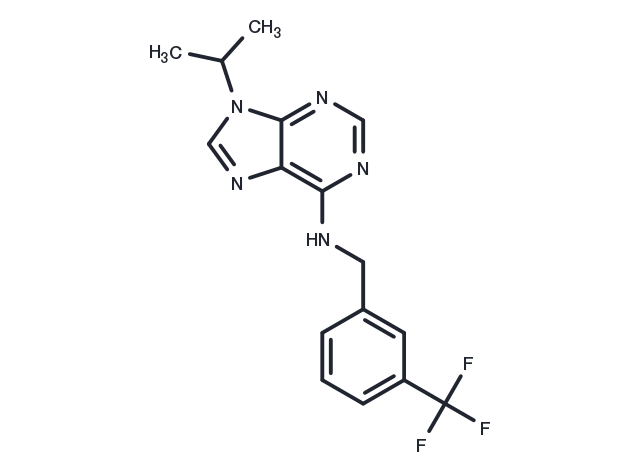Powder: -20°C for 3 years | In solvent: -80°C for 1 year


Longdaysin is an inhibitor of CK1α and CK1δ (IC50s: 5.6/8.8 μM). It also can inhibit ERK2 (IC50: 52 μM).

| Pack Size | Availability | Price/USD | Quantity |
|---|---|---|---|
| 1 mg | In stock | $ 31.00 | |
| 5 mg | In stock | $ 72.00 | |
| 10 mg | In stock | $ 117.00 | |
| 25 mg | In stock | $ 237.00 | |
| 50 mg | In stock | $ 378.00 | |
| 100 mg | In stock | $ 572.00 | |
| 1 mL * 10 mM (in DMSO) | In stock | $ 79.00 |


| Description | Longdaysin is an inhibitor of CK1α and CK1δ (IC50s: 5.6/8.8 μM). It also can inhibit ERK2 (IC50: 52 μM). |
| Targets&IC50 | CDK7:29 μM (cell free), ERK2:52 μM (cell free), CKIα:5.6 μM (cell free), CKIδ:8.8 μM (cell free) |
| In vitro | Longdaysin inhibited CKIδ, CKIα, ERK2, and CDK7 activities (IC50?=?8.8, 5.6, 52, and 29 μM, respectively), while it had much less effect on p38α. The period of CKIδ deficient cells was 1.1 h longer than that of wild type cells. Longdaysin lengthened the period in a dose-dependent manner in CKIδ deficient cells as well as in wild type cells [1]. In breast cancer Hs578T and MDA-MB-231 cells, micromolar concentrations of longdaysin attenuated the phosphorylation of LRP6 and DVL2 and reduced the expression of active β-catenin and total β-catenin, leading to the downregulation of Wnt target genes Axin2, DKK1, LEF1, and Survivin [2]. |
| In vivo | In MDA-MB-231 breast cancer xenografts, treatment with longdaysin suppressed tumor growth in association with inhibition of Wnt/β-catenin signaling [2]. |
| Kinase Assay | The CKIδ, CKIα, CDK7, and ERK2 kinase assays were performed on 384-well plates (10 μl volume). The reaction mixture was as follows: for CKIδ, 2 ng/μl CKIδ, 50 μM peptide substrate RKKKAEpSVASLTSQCSYSS corresponding to human PER2 Lys659-Ser674, and CKI buffer (40 mM Tris, 10 mM MgCl2, 0.5 mM DTT, 0.1 mg/ml BSA, pH 7.5); for CKIα, 1 ng/μl CKIα, 50 μM CKI peptide substrate, and CKI buffer; for CDK7, 5 ng/μl CDK7, 100 μM Cdk7/9 peptide substrate, and CKI buffer; for ERK2, 1.5 ng/μl ERK2, 0.8 μg/μl MBP, and ERK buffer (50 mM Tris, 10 mM MgCl2, 0.5 mM DTT, 1 mM EGTA, pH 7.5). Five hundred nl of compound was added to the mixture (final 5% DMSO), and the reaction was started by adding ATP (final 5 μM). After incubation at 30°C for 3h, 10 μl of Kinase-Glo Luminescent Kinase Assay reagent was added, and the luminescence was detected to determine the remaining ATP amount. All of the tested compounds did not inhibit luciferase activity directly [1]. |
| Cell Research | 2×10^5 cells were suspended in 100 μL serum-free medium containing the indicated concentrations of longdaysin, and then seeded in 24-transwell chambers with 8 μm pore membrane. The lower chamber contained medium with 20% FBS. After incubation at 37°C for 6 hours, the unmigrated cells on the upper side of membrane were removed by a cotton swab, and the migrated cells were stained with crystal violet and stained cells were photomicrographed. For invasion assays, the transwell chambers with 8 μm pore membranes were coated with Matrigel [2]. |
| Animal Research | MDA-MB-231 cells were injected s.c. into the right flank of nude mice (1×10^7 cells per mouse), and tumor growth was closely observed and measured every 3 days. When the tumors reached approximately 50 mm3, the mice were randomly divided into two groups (eight mice per group) and i.p. injected with the vehicle (0.8% DMSO/12% Cremophor/8% ethanol in normal saline) or 5 mg/kg longdaysin in vehicle every 3 days. This longdaysin dosage was selected based on results from preliminary experiments, and was well tolerated in the mouse model. Subsequently, tumor volumes were measured with a caliper and calculated as follows: 0.523×(length)×(width)2. After treatment for 3 weeks, the mice were sacrificed and the tumor tissues were collected and weighed before being fixed in buffered formalin [2]. |
| Molecular Weight | 335.33 |
| Formula | C16H16F3N5 |
| CAS No. | 1353867-91-0 |
Powder: -20°C for 3 years | In solvent: -80°C for 1 year
DMSO: 100 mg/mL (298.21 mM)
H2O: Insoluble
You can also refer to dose conversion for different animals. More
bottom
Please see Inhibitor Handling Instructions for more frequently ask questions. Topics include: how to prepare stock solutions, how to store products, and cautions on cell-based assays & animal experiments, etc.
Longdaysin 1353867-91-0 Cell Cycle/Checkpoint MAPK Metabolism Stem Cells Casein Kinase ERK CDK Cyclin dependent kinase inhibit Inhibitor Extracellular signal regulated kinases inhibitor
